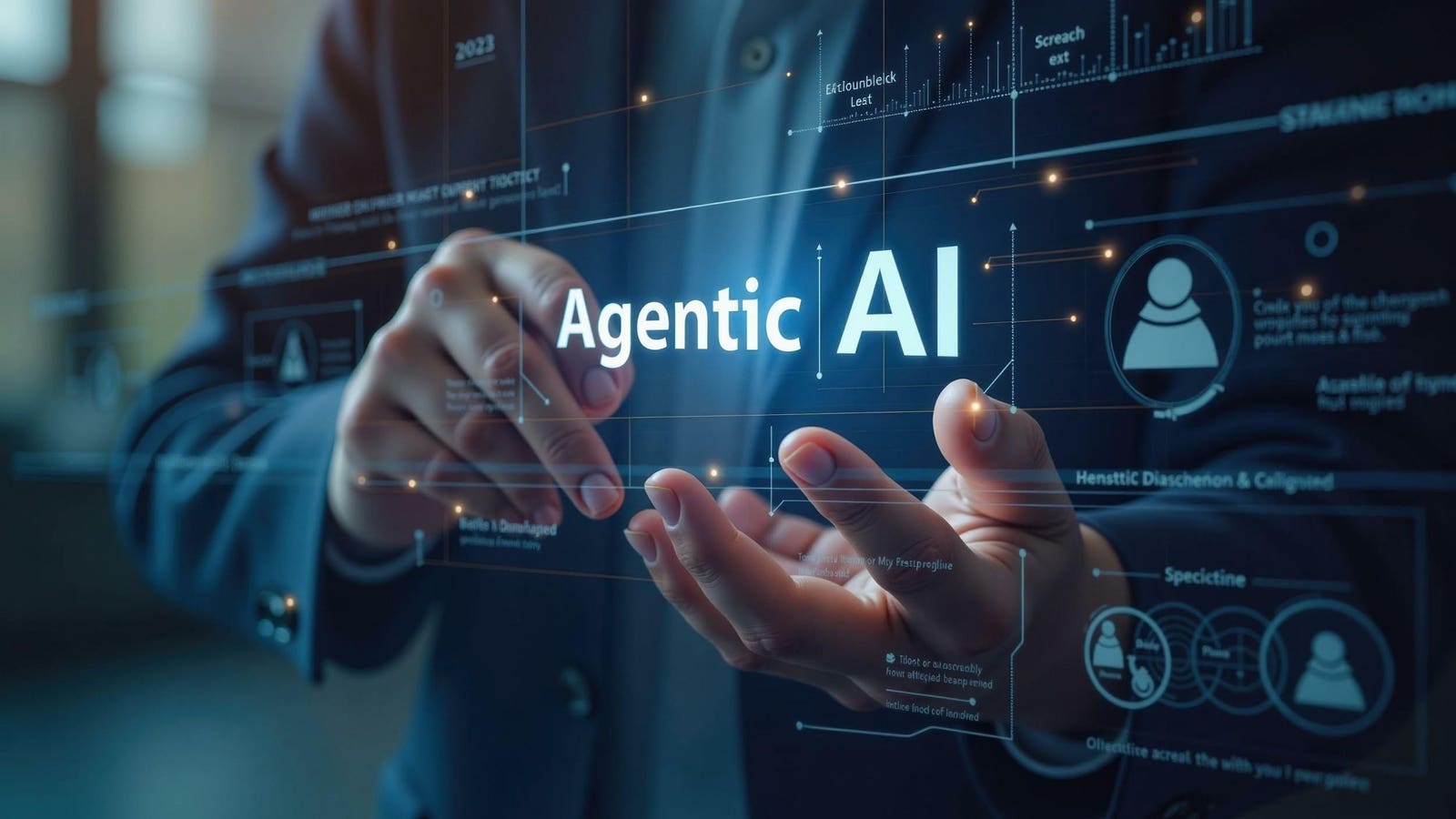Innovation and Technology
What Sets Agentic AI Apart From Today’s AI Tool

The key distinction between generative and agentic AI lies in their approach to tasks and decision-making. Generative AI, which powers popular tools like ChatGPT, Google Gemini and Claude, works like an incredibly sophisticated pattern-matching and completion system. When you prompt it, it analyzes vast amounts of training data to generate appropriate responses, whether that’s writing a poem, creating an image, or helping debug code. While this is hugely impressive, these systems are essentially reactive; they respond to specific prompts without any real understanding of context or long-term objectives.
Agentic AI operates with a degree of autonomy. These systems can set their own goals, develop strategies to achieve them and adapt their approach based on changing circumstances. Think of generative AI as a highly skilled assistant waiting for instructions, while agentic AI is more like a colleague who can take the initiative and work independently toward broader objectives.
The Building Blocks Of Intelligence And Purpose
What makes agentic AI truly revolutionary is its architecture. While generative AI excels at processing and producing content based on patterns in its training data, agentic systems incorporate sophisticated planning modules, memory systems, and decision-making frameworks that allow them to maintain context and pursue objectives over time. They can break down complex tasks into manageable steps, prioritize actions, and even recognize when their current approach isn’t working and needs adjustment.
The Convergence of Generative and Agentic AI
We’re beginning to see the first signs of convergence between generative and agentic capabilities in mainstream AI tools. OpenAI’s recent introduction of scheduled tasks in ChatGPT represents an early step in this direction. This feature allows the AI to operate semi-autonomously, performing scheduled actions and maintaining ongoing responsibilities without constant user prompting. While still in its early stages, it points to a future where AI systems combine the creative and analytical capabilities of generative AI with the autonomous decision-making of agentic AI.
Real-World Applications And Implications
The practical applications of agentic AI are potentially far-reaching and transformative. Imagine an AI system that doesn’t just help schedule your meetings but actively manages your entire workflow, anticipating bottlenecks, suggesting process improvements, and autonomously handling routine tasks without constant supervision. In manufacturing, agentic AI could manage entire production lines, not just by following pre-programmed routines but by actively optimizing processes and responding to unexpected challenges in real time.
The Future Of Human-Machine Collaboration
As agentic AI systems become more sophisticated, we’re likely to see a fundamental shift in how we interact with artificial intelligence. Rather than simply issuing commands and receiving outputs, we’ll develop more collaborative relationships with AI systems that can engage in genuine back-and-forth dialogue, propose alternative solutions, and even challenge our assumptions when appropriate. This evolution could lead to unprecedented levels of human-machine synergy, where AI becomes less of a tool and more of a partner in problem-solving and innovation.
Looking Ahead: Challenges And Opportunities
The development of agentic AI isn’t without its challenges. Questions about decision-making transparency, ethical boundaries, and appropriate levels of autonomy need careful consideration. How do we ensure these systems remain aligned with human values and interests while maintaining their ability to operate independently? How do we balance the benefits of increased automation with the need for human oversight and control? These are critical questions that will shape the future development of agentic AI systems.
Shaping Tomorrow’s Intelligence Today
The shift from purely generative to more agentic AI represents a fundamental reimagining of what artificial intelligence can be. As these systems become more sophisticated and widespread, they have the potential to transform industries, enhance human capabilities, and open new frontiers in human-machine collaboration. The key will be ensuring that we develop and deploy these technologies thoughtfully, with clear frameworks for accountability and control.
Conclusion
Agentic AI is poised to revolutionize the way machines think and act independently, offering a new era of human-machine collaboration and problem-solving. As we move forward, it’s crucial to address the challenges and opportunities presented by this emerging technology, ensuring that we harness its potential to benefit society as a whole.
FAQs
- What is agentic AI?
Agentic AI is a type of artificial intelligence that operates with a degree of autonomy, setting its own goals, developing strategies to achieve them, and adapting its approach based on changing circumstances. - How does agentic AI differ from generative AI?
Agentic AI incorporates sophisticated planning modules, memory systems, and decision-making frameworks, allowing it to maintain context and pursue objectives over time, whereas generative AI excels at processing and producing content based on patterns in its training data. - What are the potential applications of agentic AI?
Agentic AI has the potential to transform industries, enhance human capabilities, and open new frontiers in human-machine collaboration, with applications in areas such as workflow management, manufacturing, and problem-solving.
Innovation and Technology
Protect Yourself Against AI Cybercrime
Innovation and Technology
Digital Transformation in Healthcare: Strategies for Improving Patient Outcomes

With digital transformation strategies, healthcare organizations can revolutionize the way they deliver care, improving patient outcomes and enhancing the overall healthcare experience. By leveraging technology, healthcare providers can streamline clinical workflows, enhance patient engagement, and make data-driven decisions. In this article, we will explore the various digital transformation strategies that can be employed in healthcare to improve patient outcomes.
Introduction to Digital Transformation in Healthcare
Digital transformation in healthcare refers to the integration of digital technology into all areas of healthcare, from patient engagement to clinical decision-making. This transformation has the potential to improve patient outcomes, reduce healthcare costs, and enhance the overall quality of care. With the increasing demand for high-quality, patient-centered care, healthcare organizations are under pressure to adopt digital transformation strategies that can help them stay ahead of the curve.
Benefits of Digital Transformation in Healthcare
The benefits of digital transformation in healthcare are numerous. Some of the key benefits include improved patient outcomes, enhanced patient engagement, and increased efficiency. Digital transformation can also help healthcare organizations to reduce costs, improve care coordination, and enhance the overall quality of care. Additionally, digital transformation can enable healthcare organizations to make data-driven decisions, which can lead to better patient outcomes and improved population health.
Digital Transformation Strategies for Improving Patient Outcomes
There are several digital transformation strategies that healthcare organizations can employ to improve patient outcomes. Some of these strategies include telemedicine, artificial intelligence, and data analytics. Telemedicine, for example, can enable healthcare providers to remotely monitor patients, reducing the need for hospitalizations and improving patient outcomes. Artificial intelligence can help healthcare providers to analyze large amounts of data, identifying patterns and trends that can inform clinical decision-making.
Telemedicine: A Key Digital Transformation Strategy
Telemedicine is a digital transformation strategy that enables healthcare providers to remotely deliver care to patients. This can include video consultations, remote monitoring, and mobile health applications. Telemedicine has the potential to improve patient outcomes by increasing access to care, reducing hospitalizations, and enhancing patient engagement. Additionally, telemedicine can help healthcare organizations to reduce costs, improve care coordination, and enhance the overall quality of care.
Artificial Intelligence: Enhancing Clinical Decision-Making
Artificial intelligence is a digital transformation strategy that can help healthcare providers to analyze large amounts of data, identifying patterns and trends that can inform clinical decision-making. Artificial intelligence can be used to analyze medical images, diagnose diseases, and develop personalized treatment plans. Additionally, artificial intelligence can help healthcare providers to predict patient outcomes, identify high-risk patients, and develop targeted interventions.
Implementing Digital Transformation Strategies
Implementing digital transformation strategies in healthcare requires a thoughtful and multi-step approach. Healthcare organizations must first assess their current technology infrastructure, identifying areas for improvement and opportunities for growth. They must then develop a digital transformation strategy, which outlines their goals, objectives, and key performance indicators. Additionally, healthcare organizations must ensure that they have the necessary resources and support in place to implement their digital transformation strategy.
Change Management: A Critical Component of Digital Transformation
Change management is a critical component of digital transformation in healthcare. Healthcare organizations must ensure that they have a clear change management strategy in place, which outlines their approach to communicating change, training staff, and addressing resistance. This can include providing training and support to staff, communicating the benefits of digital transformation, and addressing concerns and resistance.
Overcoming Barriers to Digital Transformation
There are several barriers to digital transformation in healthcare, including regulatory barriers, financial barriers, and cultural barriers. Regulatory barriers, for example, can include concerns about data privacy and security, while financial barriers can include the high cost of implementing digital transformation strategies. Cultural barriers, on the other hand, can include resistance to change and a lack of digital literacy among staff.
Addressing Regulatory Barriers to Digital Transformation
Regulatory barriers to digital transformation in healthcare can be addressed by ensuring that healthcare organizations are compliant with relevant regulations, such as the Health Insurance Portability and Accountability Act (HIPAA). This can include implementing robust data security measures, ensuring that staff are trained on data privacy and security, and conducting regular audits and risk assessments.
Conclusion
In conclusion, digital transformation strategies have the potential to revolutionize the way healthcare is delivered, improving patient outcomes and enhancing the overall healthcare experience. By leveraging technology, healthcare providers can streamline clinical workflows, enhance patient engagement, and make data-driven decisions. However, implementing digital transformation strategies requires a thoughtful and multi-step approach, which includes assessing current technology infrastructure, developing a digital transformation strategy, and ensuring that necessary resources and support are in place.
Frequently Asked Questions (FAQs)
What is digital transformation in healthcare?
Digital transformation in healthcare refers to the integration of digital technology into all areas of healthcare, from patient engagement to clinical decision-making.
What are the benefits of digital transformation in healthcare?
The benefits of digital transformation in healthcare include improved patient outcomes, enhanced patient engagement, and increased efficiency.
What are some common digital transformation strategies in healthcare?
Some common digital transformation strategies in healthcare include telemedicine, artificial intelligence, and data analytics.
How can healthcare organizations overcome barriers to digital transformation?
Healthcare organizations can overcome barriers to digital transformation by addressing regulatory barriers, financial barriers, and cultural barriers. This can include ensuring compliance with relevant regulations, providing training and support to staff, and communicating the benefits of digital transformation.
Innovation and Technology
Building an AI-Ready Corporate Culture

A few decades back, management guru Peter Drucker made the observation that “culture eats strategy for breakfast.” meaning that without a responsive, forward-looking corporate culture, even the most meticulously planned business strategy will fall flat.
Introduction to the Concept
In other words, just as people make the world go ‘round, and people make the business go ’round, it’s going to take people to make artificial intelligence go ’round. For organizations moving full-steam into AI, Drucker’s time-tested words still ring true. Culture will eat any AI strategy for breakfast, and perhaps lunch too.
Approaches for a Well-Functioning AI Strategy
There are some approaches that leaders seeking to pursue a well-functioning AI strategy can follow that can help integrate it into corporate culture. West Monroe, an analyst group, recently published practical guidelines for building a thriving culture that embraces – not repels – AI.
Key Points for Integration
The following are key points for integrating AI into corporate culture:
- Visualize a successful AI operating model. It’s essential to have a compelling vision of what exactly AI will bring to the business. An ideal AI operating culture provides for a natural flow of work between human talent and AI systems. AI is good at some things, humans at others – such as creativity, judgement and empathy. “Organizations that first define what success looks like – automating simple and routine tasks, enhancing customer experiences or improving decision-making—will maximize ROI,” the West Monroe co-authors state. “Without this alignment, AI will remain an expensive, underleveraged asset rather than a business enabler.”
- Set realistic expectations. “Asking employees to blindly trust AI without understanding its role leads to skepticism and resistance. Instead, organizations should clarify AI’s purpose: Is it an advisor, an efficiency tool, or an automated assistant? Setting realistic expectations ensures AI is seen as an enabler, not a disruptor.”
- Build a collaborative culture around AI. For starters, AI should be accessible – in some shape or form – to all. It’s not an IT or data analyst project, it’s everyone’s concern. “Foster a culture that rewards collaboration over territorial thinking,” the West Monroe team urges. “Employees need the assurance that they can experiment with AI to test outcomes. Leaders need to clearly define the purpose of AI within the organization.”
- Position AI agents as “interns.” “Think of an internal AI chatbot as providing each employee with a permanent intern that has perfect recall, access to vast knowledge, and continually improves over time,” the co-authors advise. “Letting this ‘intern’ handle routine tasks frees your team to focus on higher-value work that requires uniquely human skills.”
- Educate and train. Then educate and train some more. “Not every employee needs to become an AI expert, but every employee should have a clear, baseline understanding of how AI can impact their role,” West Monroe urges. “A nurse, for example, doesn’t need to engineer AI algorithms to treat patients but should trust AI-driven diagnostic tools while still applying human judgement.”
- Measure, measure, measure. “AI’s impact isn’t just about automation – it’s about measurable business outcomes,” the co-authors state. Metrics key to AI progress include productivity gains, cost reductions, decision-making quality, employee adoption rates, customer experience improvements and performance improvement.
- Prioritize change management. “AI adoption can often falter not because the technology itself is flawed but because organizations struggle with change,” according to West Monroe. “Many companies operate in environments resistant to innovation, where entrenched processes, risk aversion, and siloed thinking create barriers. Companies must first assess their readiness for change to break this cycle.”
Conclusion
Companies need to integrate AI into existing processes and their DNA rather than treating it as a standalone project. To get there, full employee engagement is the path to success. By following these guidelines and understanding the importance of culture in AI implementation, businesses can ensure that their AI strategies are not only successful but also beneficial to the organization as a whole.
FAQs
- Q: Why is culture important for AI strategy?
A: Culture is crucial because it determines how well employees adapt to and utilize AI technologies, thereby affecting the success of the AI strategy. - Q: How can leaders promote a collaborative culture around AI?
A: Leaders can foster a collaborative culture by making AI accessible to all employees, encouraging experimentation, and defining the purpose of AI within the organization. - Q: What are the key metrics for measuring AI’s impact?
A: Key metrics include productivity gains, cost reductions, decision-making quality, employee adoption rates, customer experience improvements, and performance improvement. - Q: Why is change management important for AI adoption?
A: Change management is vital because AI adoption often falters due to organizational resistance to change, and assessing readiness for change can help break this cycle.
-

 Career Advice5 months ago
Career Advice5 months agoInterview with Dr. Kristy K. Taylor, WORxK Global News Magazine Founder
-

 Diversity and Inclusion (DEIA)5 months ago
Diversity and Inclusion (DEIA)5 months agoSarah Herrlinger Talks AirPods Pro Hearing Aid
-

 Career Advice5 months ago
Career Advice5 months agoNetWork Your Way to Success: Top Tips for Maximizing Your Professional Network
-

 Changemaker Interviews4 months ago
Changemaker Interviews4 months agoUnlocking Human Potential: Kim Groshek’s Journey to Transforming Leadership and Stress Resilience
-

 Diversity and Inclusion (DEIA)5 months ago
Diversity and Inclusion (DEIA)5 months agoThe Power of Belonging: Why Feeling Accepted Matters in the Workplace
-

 Global Trends and Politics5 months ago
Global Trends and Politics5 months agoHealth-care stocks fall after Warren PBM bill, Brian Thompson shooting
-

 Global Trends and Politics5 months ago
Global Trends and Politics5 months agoUnionization Goes Mainstream: How the Changing Workforce is Driving Demand for Collective Bargaining
-

 Training and Development5 months ago
Training and Development5 months agoLevel Up: How Upskilling Can Help You Stay Ahead of the Curve in a Rapidly Changing Industry












